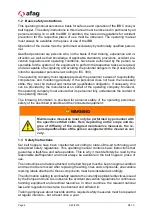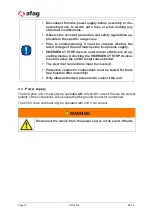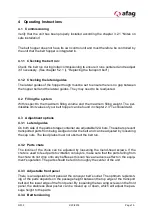
R01.0
2/20/2018
Page 15
4
Operating Instructions
4.1
Commissioning
Verify that the unit has been properly
installed according the chapter 3.2.1 “Notes on
safe installation”
The belt hopper does not have its own control unit and must therefore be controlled by
the unit that the belt hopper is integrated in.
4.1.1
Checking the belt run:
Check the belt run during initial commissioning to ensure it runs centered and readjust
it if necessary. (See chapter 5.2.1 i), “Replacing the transport belt”)
4.1.2
Checking the lateral guides
The lateral guides of the hopper trough must be set to ensure there is no gap between
the hopper belt and the lateral guides. They may need to be readjusted.
4.2
Filling the system
With respect to the maximum filling volume and the maximum filling weight. The per-
missible limit values of your belt hopper can be found in chapter 2.3 “Technical data”.
4.3
Adjustment options
4.3.1
Lateral guides
On both side of the parts storage container are adjustable V2A bars. These bars prevent
transported parts from being wedged under the belt and can be adjusted by loosening
the cap nuts. The feed plates must not obstruct the belt run.
4.3.2
Parts chute
The incline of the chute can be adjusted by loosening the round-head screws. If the
chute is used to feed parts to vibration conveyors, make sure that the parts falling from
the chute do not drop onto any baffles as this can have an adverse effect on the equip-
ment's operation. The parts should be fed into roughly the center of the unit.
4.3.3
Adjustable front panel
There is an adjustable front panel at the conveyor belt’s outlet. The optimum replenish-
ing of the parts depends on the passage height between the top edge of the transport
belt and the lower edge of the front panel. By loosening the two wing screws on the front
panel, the stainless steel pusher can be moved up or down, which will adjust the pas-
sage height to the parts.
4.3.4
Belt tensioning
Содержание 50494738
Страница 22: ...Page 22 2 20 2019 R01 0 ...








































